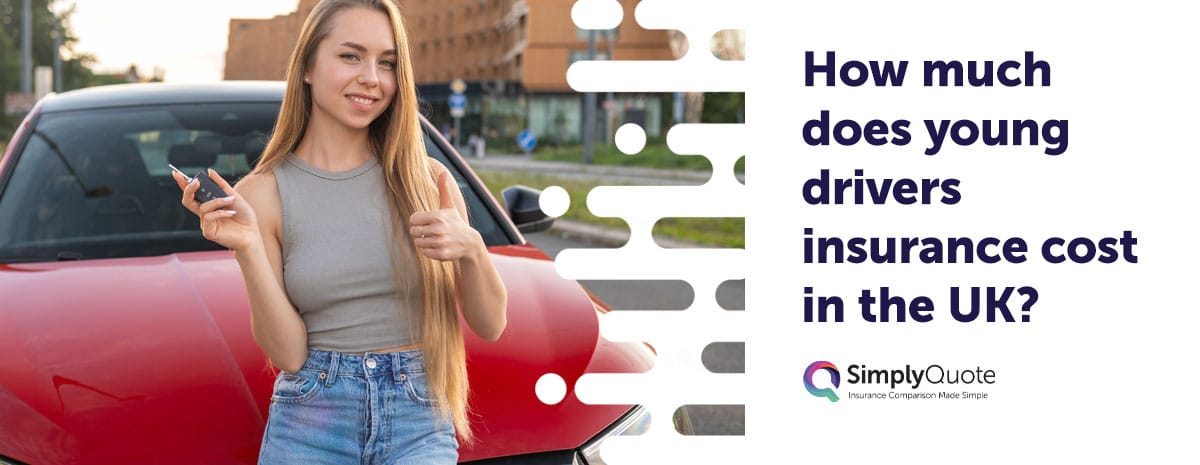How much does young drivers insurance cost in the UK?
In 2025, the average premium for 17–24-year-olds has dipped to £834 a year—its largest percentage drop since 2014. However, if you’ve just turned 17, that figure can spike to £2,877, and automatic-only licences average around £2,803.
While some drivers are saving, these numbers still leave many young motorists wondering how they can manage the cost. In this guide, we’ll unpack why these premiums are so high, share the most recent stats, and reveal how you can shave hundreds off your bill—even as a new driver.

Looking for young driver insurance? Get your quote today!
Get QuotesWhy are young driver insurance costs still high?
Even with recent drops, younger motorists remain riskier bets—at least in the eyes of insurers.
A limited driving record and higher incident rates can push up your premium. There’s also the lifestyle aspect: Students or young professionals may drive more at night or in congested areas, increasing accident probabilities.
Car choice matters too. If you pick a powerful hatchback with modifications, you’re flagged as higher risk. Meanwhile, some 17-year-olds stick to smaller, second-hand vehicles with minimal safety features—which can also lead to pricier quotes if insurers believe repairs or replacements will be costly after a collision.
Ultimately, insurers gauge any factor that might boost the likelihood of a claim. The more uncertain or risky you appear, the higher your premium climbs.
How much will you pay at 17 vs. 24?
When you’re 17, an average of £2,877 is common, reflecting zero no-claims bonus and general lack of experience.
By 24, some drivers see costs drop closer to £834, thanks to a couple of claim-free years under their belt.
- Yearly Shifts: Recent data points to a 12% decrease in 17-year-old premiums over a few months. If that trend continues, the gap between 17 and 24 might narrow faster than expected.
- 24-Year-Olds: Though not always “cheap,” many find they can at least handle the costs with responsible driving and possibly telematics.
Can telematics really help young drivers?
Yes, telematics (or “black box” insurance) can substantially trim premiums—especially if you drive cautiously.
Instead of relying on your age, insurers look at how you actually drive: speed, braking, cornering, and whether you frequently travel late at night.
- 25–29-Year-Olds: On average, telematics slashes costs from £821.24 to £701.57.
- Younger Drivers: Might see even bigger gains since the black box helps disprove “high-risk” assumptions if you have safe habits.
Looking for new driver insurance? Get your quote today!
Get QuotesWhy everything changes at 35
By the time you’re 35, your premium might settle around £990, which can feel like a dream compared to what you paid in your teens.
Several years of safe driving, a likely no-claims bonus, and generally fewer “risk-taking” behaviours lead insurers to see you as low-risk. While waiting for age to catch up isn’t the most exciting strategy, a consistent record of clean driving does wonders for your wallet in the long run.
Final thoughts
It’s no secret that being a young driver means higher insurance bills, but 2025 offers more hope than frustration for many. The average cost of £834 for 17–24-year-olds and the 12% drop for 17-year-olds in just three months show genuine improvements.
If you’re feeling overwhelmed, remember that small steps—picking a modest car, trying telematics, and racking up no-claims—can yield real progress.
Yes, you’ll probably pay more than a veteran driver at 35, but the difference narrows each year you steer clear of accidents and build your policy history. Stick with it, stay safe, and you might be pleasantly surprised at how much you can save when renewal time rolls around.
Frequently Asked Questions (FAQs)
Not exactly—most set it at under 25, but some extend it or focus on length of driving experience.
Often, yes, if they’re genuinely using the car. But avoid “fronting” (claiming they’re the main driver when they’re not) as it’s illegal.
Many do, especially engine tweaks or body kits. Mild cosmetic changes might or might not affect costs. Always check with your insurer.
Some telematics plans are cheaper monthly but require an installation or device fee. Weigh the initial costs against potential savings.
You start earning it right away. Each year you remain claim-free should shrink your premium, sometimes by a notable percentage.
It can raise costs, but usually not dramatically unless you already have points. Being transparent is key, or you risk invalidating your policy.
Usually, yes. Monthly instalments often include interest or service charges.
Insurers see it as limiting your driving flexibility. Plus, automatics can be pricier to repair if damaged.
